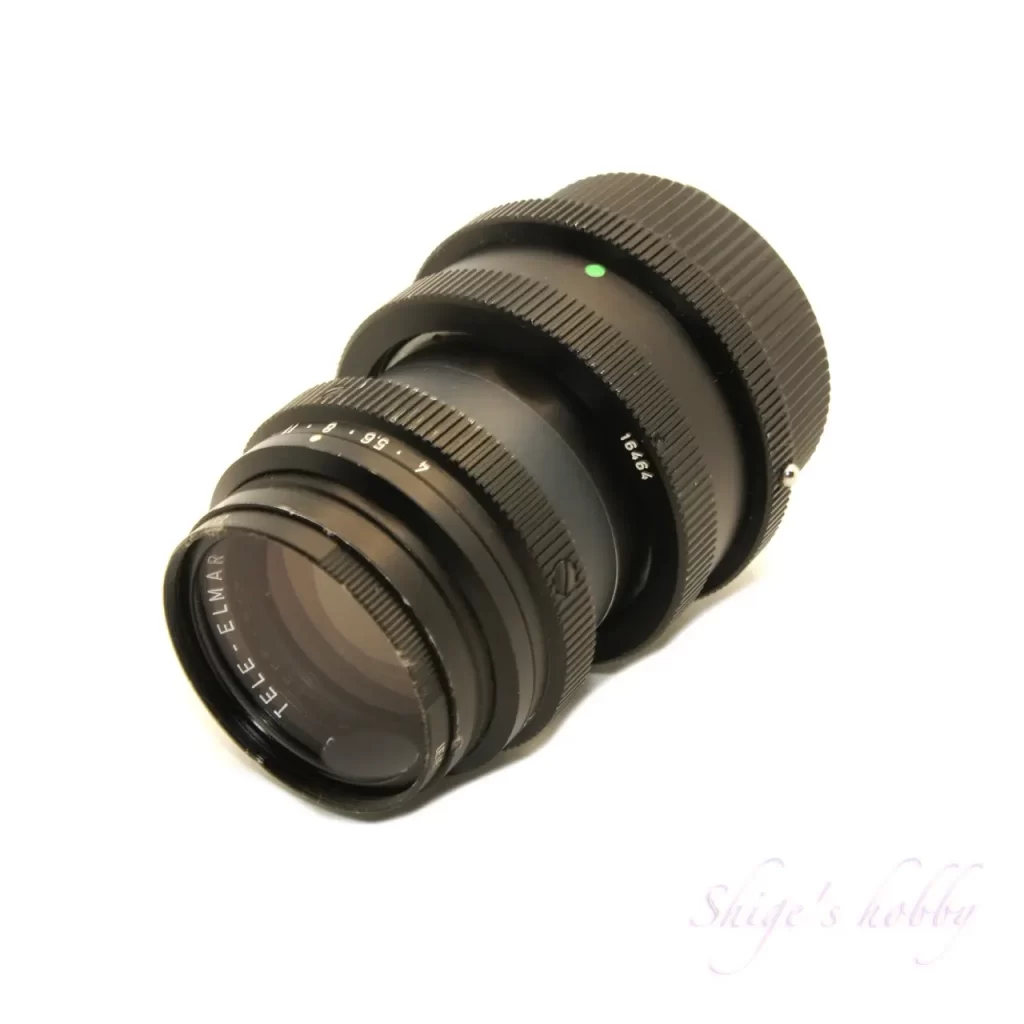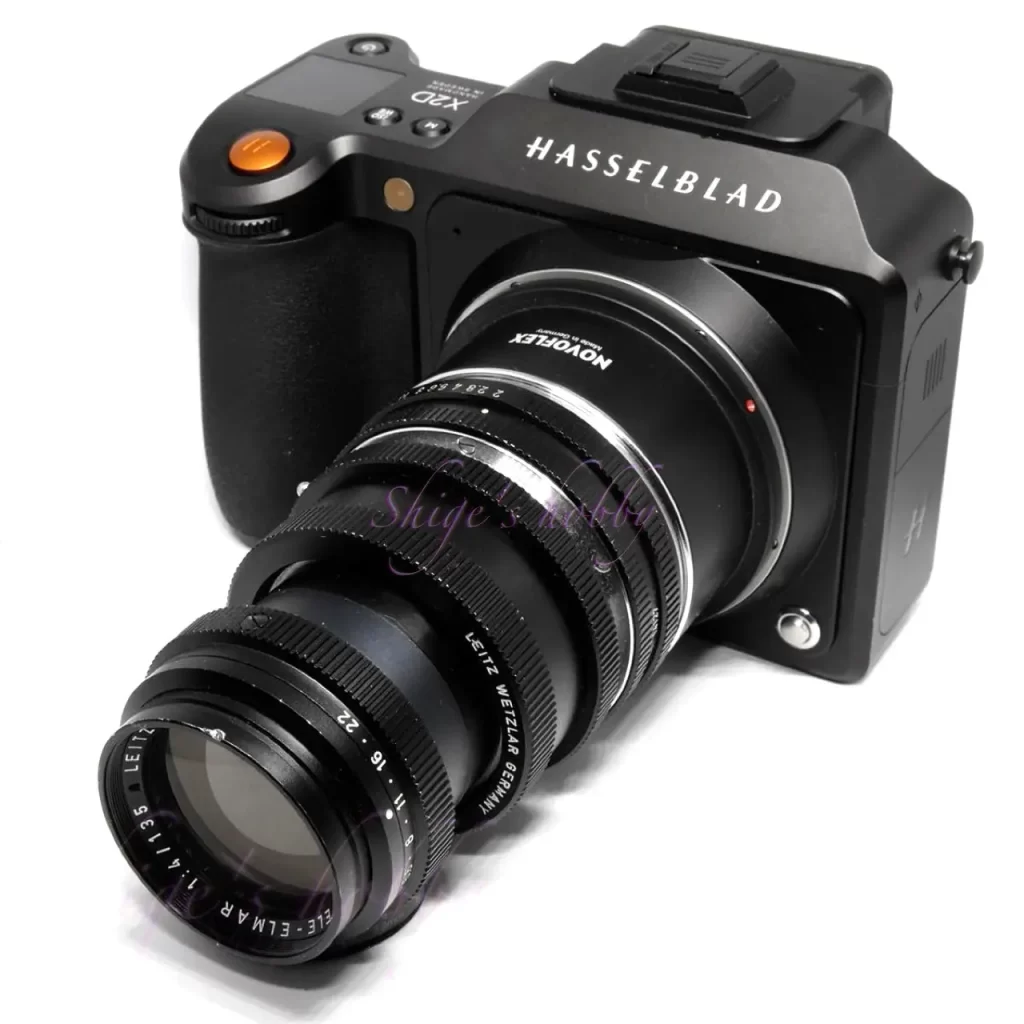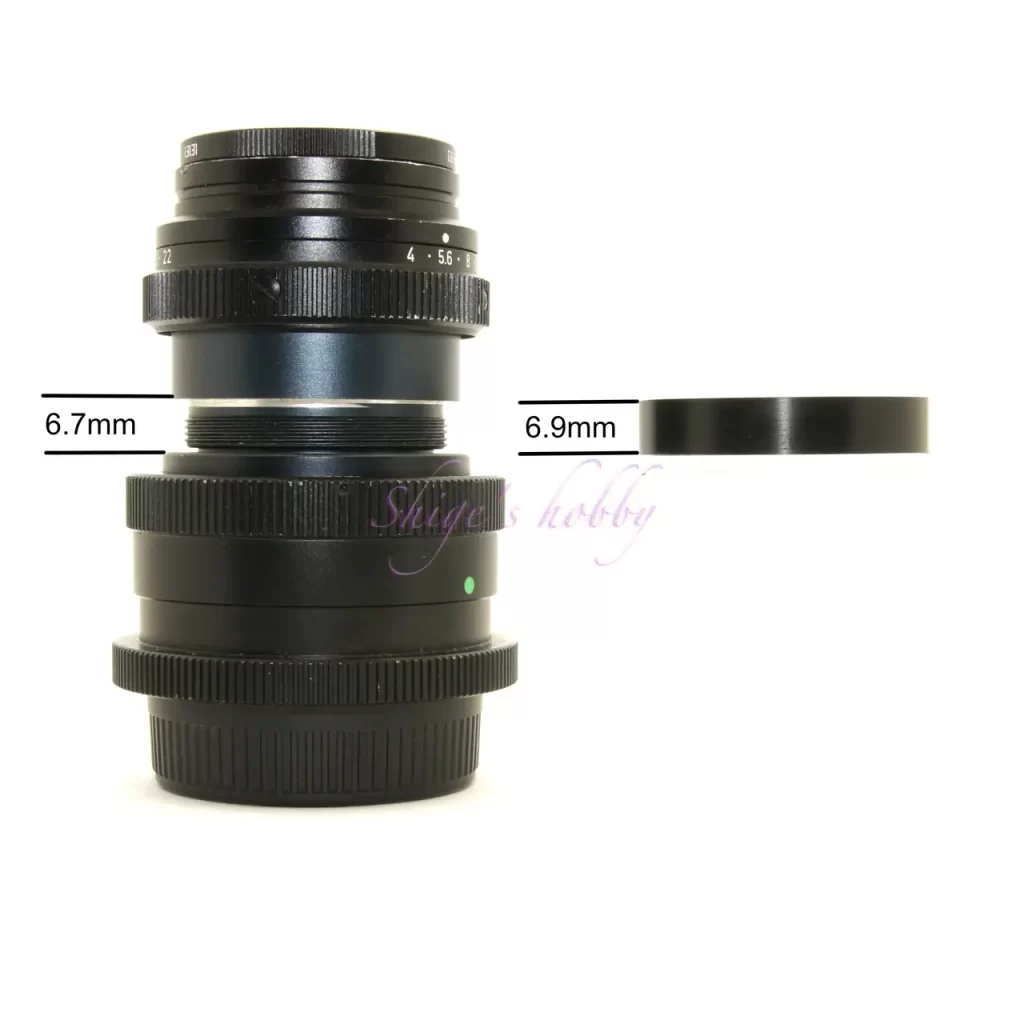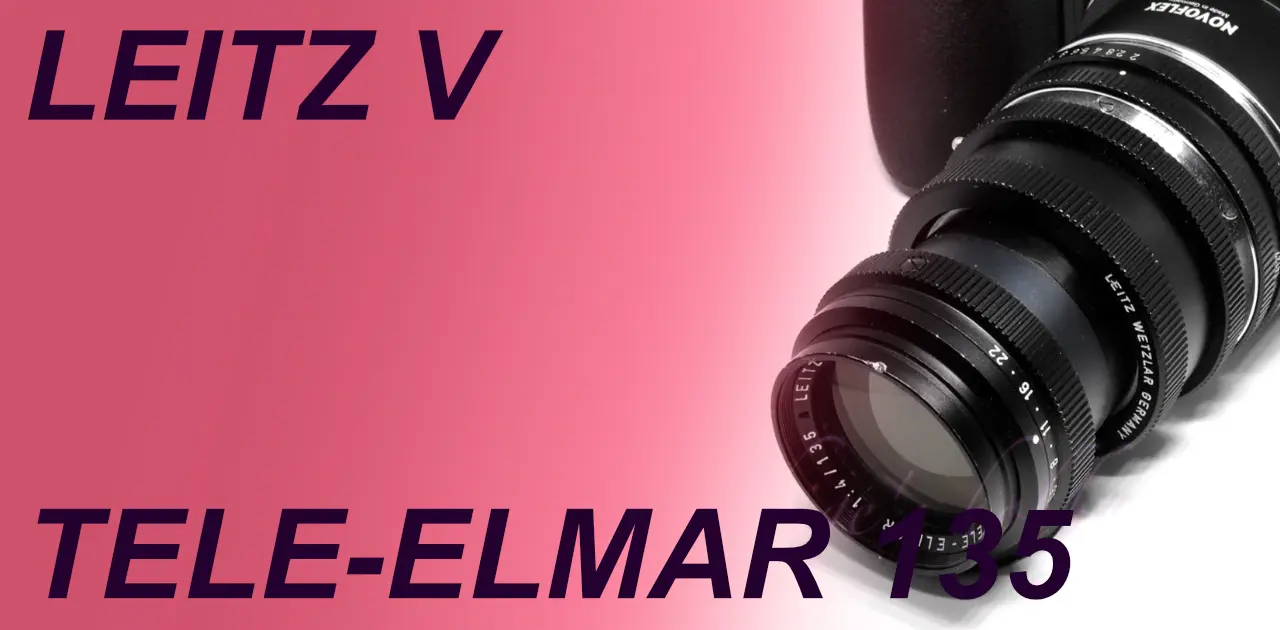A review and photo examples of the TELE ELMAR 13.5cm F4 lens converted from a LEICA M mount to a VISOFLEX-M mount, used with digital SLR and mirrorless cameras.
- Please see the disclaimer regarding advertising here.
- Italicized links in the text are advertisement links that take you to other sites.
Table of contents
Gallery
写真作例の撮影は以下のカメラを使用した。
- EOS-1Ds Mark-III
- EOS 7D
- HASSELBLAD X2D-100C
Review

1.Overview
The TELE ELMAR 13.5cm F4 is a Leica M-mount lens that can be used with M-mount cameras or converted to a VISOFLEX-M by using the Leica helicoid 16464/OTZFO. The VISOFLEX-M can also be converted to a Leica R-mount by using the mount adapter Leica 14167.
The minimum focusing distance is 0.9m when using the helicoid 16464/OTZFO, and 1.5m when using the original M-mount helicoid. The 16464/OTZFO helicoid can also be used with this lens and the ELMAR 65mm F3.5.
The hood used is 12575/IUFOO, which is the same for both the 90mm and 135mm lenses. It can be reversed for easy transport.
2.Usability
The TELE ELMAR 13.5cm F4 introduced here is an older model from before 1992, and I purchased it with the “16464/OTZFO” VISO-M helicoid attached for a few thousand yen. I recall the lens and the separately purchased hood (12575/IUFOO) being about the same price. The lens head is still available for purchase, but it’s no longer as cheap as it was back then.
This lens has an aperture value of 4, and while there are no issues with viewfinder brightness when used with a standard SLR viewfinder matte lens, you may find it dark with focus-focused matte lenses.
As for focusing, I don’t use long-focus lenses with a focal length of 135mm with rangefinder cameras because the focusing accuracy is questionable, and I don’t use them with cameras like the Leica M series.
When used with an SLR camera, the maximum aperture is only F4, which is not very bright, so there are few issues with focusing during the day, but in low light situations such as in the evening, the image in the viewfinder is dark, making it difficult to focus, and when taking photos, the shutter speed decreases, posing the risk of camera shake.
Next, I’ll describe my experience using it with each camera.
■ VISOFLEX SLR camera
The VISOFLEX mentioned here is not an EVF for the Leica M digital camera, but a general term for a mechanism that adds an SLR mirror box to a Leica M-series rangefinder camera. While the VISOFLEX can also be used with digital M-series Leica cameras, since the LEICA M typ240 and later digital M-series cameras benefit from improved focusing accuracy when used as a mirrorless camera with an electronic viewfinder, this mechanism is likely limited to the LEICA M8, LEICA M8.2, LEICA M9, and LEICA M9-P among digital M-series Leica cameras.
The VISOFLEX comes in 1-inch, 2-inch, and 3-inch sizes. The photo below shows a slightly unusual 2-inch quick-return mirror version.
When this mechanism is attached, a mirror box is attached to an M-series Leica camera, allowing it to be used in the same way as an SLR camera. As shown in the photo below, the lightness of the M-series Leica camera is lost, resulting in a significantly larger SLR.
Even when shooting with the VISOFLEX, lens performance is no different from that of other cameras.

■ EOS series digital SLR cameras
To use this lens with a digital SLR camera, convert it to a VISO-M mount using a short helicoid (16464/OTZFO), then convert it to a Leica R mount using the Leica 14167 mount adapter. Finally, attach the LEICA R-EOS mount adapter and mount it on a digital EOS camera.
In this state, it can be used without any problems from infinity on EOS digital series cameras.
Digital EOS cameras come with three types of sensors: 35mm full-frame, APS-H, and APS-C, and it can be used without any problems on any of these cameras. The lens’s wide image circle means that even when used with the EOS 1Ds Mk-III, which has the largest sensor size, it produces images without light falloff or distortion even at the edges, so image quality can be expected to improve with smaller sensors.
With an SLR camera, you need to determine the focus position by looking at the image seen through the viewfinder. With this lens’s maximum aperture of f/4, the viewfinder is not bright, but focusing is easy.
The 35mm equivalent focal length varies depending on the camera’s sensor size; the EOS-1D Mark-IV has a focal length conversion factor of 1.3, which is equivalent to 176mm, while the EOS 7D has a focal length conversion factor of 1.6, which is equivalent to 216mm.

■ Mirrorless camera
Because mirrorless cameras have a short flange focal distance, the Leica M mount can be attached to the camera using an M-mount adapter.
The “16464/OTZFO” VISO-M mount can be attached to a camera by simply converting it to a mount compatible with the camera, just like attaching it to a digital SLR camera. Mount adapters that convert VISO-M directly to mirrorless cameras are also available.
Focusing is easier and more accurate than with an SLR camera by using the electronic viewfinder or the magnification function on the rear LCD screen, just like with other manual focus lenses.
When used with the XASSELBLAD X2D-100C, which has a larger medium-format digital sensor, the lens achieves a 108mm equivalent in 35mm format. The lens’s image circle fully covers the 44 x 33mm sensor size of digital medium-format cameras, proving that the wide image circle of 645mm, which was said to be sufficient in the film era, is indeed true.
There is no quirk in either the foreground or background bokeh, and there is no strange, circular blur. Even at F4, it is possible to achieve a soft focus and emphasize the in-focus area. The photo above shows a four-layer structure consisting of the lens body, OTFZO (16464), 16466M, and NOVOFLEX R-X mount adapter.

In order to use the lens from infinity, the flange focal length of the camera is important, and the flange focal length for the Leica mount is shown below.
| Mount name | Frange back size | note |
| L mount | 20mm | For digital mirror less camera |
| M mount | 27.8mm | |
| L39 mount | 28.8mm | The L/M mount adapter is 1mm thick. |
| R mount | 47.4mm | R-M mount adapters are provided by various companies. |
| S mount | 53.3mm | Since I can’t find an official value for the flange back, I’ll write the value by subtracting the thickness of the S-C645 adapter, 10.7mm, from the CONTAX 645 mount’s 64mm. |
| VISO-M | 68.8mm | If you use 14127, it becomes R mount. |
| VISO-L39 | 91.1mm | If you use OUBIO/16466, it will be a VISO-M mount. |
3.Summary
In conclusion, to summarize the TELE ELMAR 13.5cm f/4, you can really get the most out of this lens by removing the M mount, converting it to another mount, and using it with an SLR or mirrorless camera.
In its original Leica M mount, focusing is difficult due to the Leica M camera’s double image overlap, and the small viewfinder frame makes composing shots difficult.
Thanks to its wide image circle, the lens’s image quality is still sufficient for the 2020s, and I recommend it as a 135mm prime lens. That said, the image quality of other lenses, such as the ELMAR 135mm and HEKTOR 135mm, is not that bad either.
It may seem a bit eccentric to go to the trouble of using a slow 135mm prime lens at f/4, but since it’s a focal length that’s well-suited for flowers and portraits, you can fully enjoy the limitations of a prime lens.
Specifications, considerations, etc.
The newer Tele-Elmar, manufactured after 1992, features a new lens barrel and a modern design with a built-in hood. Only 2,700 units were produced, and it’s exclusively for the Leica M mount.
Older Leica M-mount lenses with a focal length of 90mm or longer can have their lens section separated from the M-mount helicoid. The separated lens can then be converted to a VISOFLEX-M or VISOFLEX-L39 mount using a dedicated helicoid.
Separable lenses include the Tele-Elmar 13.5cm, Elmar 13.5cm (f/4 and f/4.5), Hektor 13.5cm, Elmar 9cm, Summicron 90mm, and Elmarit 135mm.
I’d always had issues with the infinity focus of one of my lenses, so I checked to see what was wrong with the dimensions. I discovered that the protective ring covering the gap between the lens head and the OTFZO (16464) was too thick.
As shown in the diagram below, when the protective ring is removed and the helicoid and lens are attached, the gap is 6.7mm, which is not a problem as it focuses at infinity. When I measured the thickness of the protective ring, it was 7.5mm, 0.8mm longer than the 6.7mm without the protective ring. Therefore, when the protective ring is attached to the lens, the lens extends 0.8mm from the start, meaning that the lens cannot be used at infinity.
The protective ring is made of aluminum, so I took photos at infinity while gradually grinding it down with sandpaper. After grinding off 0.6mm of the protective ring to a thickness of 6.9mm, I was able to take photos at infinity. I used 200-grit sandpaper to grind it down, but I wish I had a power machining tool like a lathe for this kind of work.
The 6.7mm without the protective ring appears to be over-inflation (beyond infinity).

In order to use the lens at infinity, the flange back of the camera is important. The flange back of the Leica mount is shown below.
| Item | Tele Elmar | Elmar | Hektor | Elmar |
| focal length(mm) | 135 | ← | ← | ← |
| Maximum aperture | 4 | ← | 4.5 | ← |
| Minimum aperture | 22 | 32 | ← | ← |
| Lens configuration | 5elements in 3groups | 4elements in 4groups | 4elements in 3groups | ← |
| Minimum distance(m) | 1.5 (M-mount) | ← | ← | 1.5 (L39-mount) |
| Lens length(mm) | 63.6 (VISOFLEX-M) | 62.5 (VISOFLEX-L39) | 63.6 (VISOFLEX-L39) | 124 (L39) |
| Lens max diameter(mm) | 60 | 52 | ← | ← |
| Filter diameter(mm) | 39 | ← | ← | ← |
| Lens Hood | IUFOO 12575 | ← | ← | ? |
| Weight(g) | 342 (VISOFLEX-M) | 165 (VISOFLEX-L39) | 247 (VISOFLEX-L39) | 517 (L39) |
| Production Numbers | 28,300- | 25,900- | 108,088 | 5,500- |
| Release date | 1964〜 | 1960-1963 | 1933-1960 | 1931-1937 |
Reference links
- LEICA Wiki TELE ELMAR 4/135
- LEICA Wiki ELMAR 13.5cm F4
- LEICA Wiki HEKTOR 13.5cm F4.5
- LEICA Wiki ELMAR 13.5cm F4.5
Affiliate links
- Leica Lens・Ads by Amazon
- Leica Books・Ads by Amazon

Amazon Prime Sale
Update history
- 2025.11.18
- 2024.10.5
- 2024.05.21
- 2023.03.25



Be First to Comment